#rightbraineducationlibrary
Explore tagged Tumblr posts
Text

Baby flash cards teach your baby to learn new words and remember them.
According to Professor Makoto Shichida, flashcards are essential for early learning because:
❤️ 1. Baby flash cards provide general knowledge.
Flashcards introduce children to diverse subjects like animals, geography, and math, enhancing vocabulary and world understanding. Their visual and textual elements reinforce concepts, making learning engaging. Repetition ensures long-term information retention.
❤️ 2. Flash cards activate the baby's right brain.
Flashing cards quickly stimulates the right brain, linked to creativity and intuition. This rapid method encourages instinctual learning and quick thinking skills, fostering a dynamic learning environment.
❤️ 3. Your baby can acquire instant memory.
Flashcards engage right brain memory, promoting instant retention. This dual-brain engagement enhances information recall, benefiting both academic and everyday situations.
❤️ 4. Flash cards connect both brain hemispheres.
Flashcards integrate images and words, bridging the right and left brain. This synergy enhances memory retention, creativity, and critical thinking, providing a comprehensive learning experience.
👉Pictures are processed by the right brain, while language is processed by the left.
👉Flashcards strengthen both sides, enhancing cognitive development and recall. Regular use promotes learning and concept absorption, stimulating creativity and holistic thinking.
#babyflashcards#babyflashcard#toddlerflashcards#earlylearning#rightbraineducation#rightbraineducationlibrary
0 notes
Photo

🇵🇱 Nowy poziom w czytaniu globalnym: poszerzanie zasobu słownictwa i wiedzy o świecie. Nie ja to wymyśliłam a ktoś kto pokazał mi, że moja 2,5-latka została prawdziwym "czytaczem." Tak..nadal jestem w szoku...Maja już czyta 😁😁😁 Test był na słowach znanych i w dodatku przeprowadzała go zupełnie obca dla Mai osoba. Szczegóły wkrótce na blogu. W każdym razie trzymamy się zaleceń dla początkujących "czytaczy": koniec chaosu i przypadkowego wyboru słów. Prezentuję kategoriami po 10. Kombinuję żeby w różnych językach były różne kategorie. Na zdjęciu: nazwy drzew, emocje (włoski), wzory i linie (angielski).Największy problem mam z angielskim bo Mają widziała już mnóstwo kategorii słów zwłaszcza z #rightbraineducationlibrary ale z inspiracją przyszedł mi blog #mamtonakoncujezyka . 🇬🇧 New level in our reading program: expanding vocabulary and broadening knowledge about the world. This is not my idea but somebody's who demonstrated Maja's reading skills 😁😁😁 I am still a bit shocked as she is just 31 months old. She was given problem-solving opportunities by a ccomplete stranger. Sooner or later I will reveal all the details. Right now we stick to follow-up advice for beginning readers: no more chaos and randomly chosen words. Now I present 10 related words in each session. I try to have different categories in different languages. In the picture: trees (Polish), emotions (Italian) and lines and patterns. As my daughter has seen almost all flashcards from #rightbraineducationlibrary I have some trouble with finding completely new categories od words. #metodadomana #czytacz #reader #domanmethod #domanmum #reading📖 #wczesnanaukaczytania #czytanieglobalne #wielojęzyczność #multilingual #wczesnewspomaganierozwoju #earlylearning #wczesnaedukacja #dwulatekczyta #dwulatek #twoyearold #kartydoczytania #karolina_lubas https://www.instagram.com/p/BqajIdXHCK9/?utm_source=ig_tumblr_share&igshid=18j1uge9mpzmw
#rightbraineducationlibrary#mamtonakoncujezyka#metodadomana#czytacz#reader#domanmethod#domanmum#reading📖#wczesnanaukaczytania#czytanieglobalne#wielojęzyczność#multilingual#wczesnewspomaganierozwoju#earlylearning#wczesnaedukacja#dwulatekczyta#dwulatek#twoyearold#kartydoczytania#karolina_lubas
0 notes
Text

❤️👉Homeschooling for 1, 2, and 3 years olds are the most important for their brain development.
The early years are crucial for your child's cognitive and physical development. Homeschooling infants and toddlers is easy, fun, and ideal during this time.
❤️Why choose to homeschool your 1, 2, and 3-year-olds?
Homeschooling young children is rewarding due to significant brain development in the first three years. This period is critical for forming neural connections, laying the foundation for future learning. Homeschooling allows for a personalized approach, fostering a love for learning and allowing parents to instill family values and monitor progress closely.
❤️What to Teach Your 1, 2, and 3-Year-Old Infant and Toddler?
Focus on foundational skills in math, vocabulary, and encyclopedic knowledge using flashcards and interactive activities. Incorporate music, storytelling, and everyday situations to enhance learning and curiosity.
❤️What Homeschooling Activities
Keep lessons short and engaging to match young children's attention spans. Use flashcards and outdoor activities to introduce new concepts, balancing cognitive and physical development through movement and play.
❤️Homeschool Curriculum for your child
Use a variety of flashcards covering math, vocabulary, and science. Lessons should be based on the child's interests and last about 5 minutes. A proper curriculum begins at elementary school age.
❤️Homeschooling Materials for 1, 2, and 3-Year-Olds
Gather engaging materials to enrich vocabulary and basic skills. Use resources like the Right Brain Education Library for flashcards and exercises. Incorporate music, movement, and art to enhance development and make learning enjoyable.
❤️In conclusion, homeschooling young children should be a joyful experience filled with exploration.
With the right materials and environment, you can support your child's development and foster a lifelong love of learning.
0 notes
Text
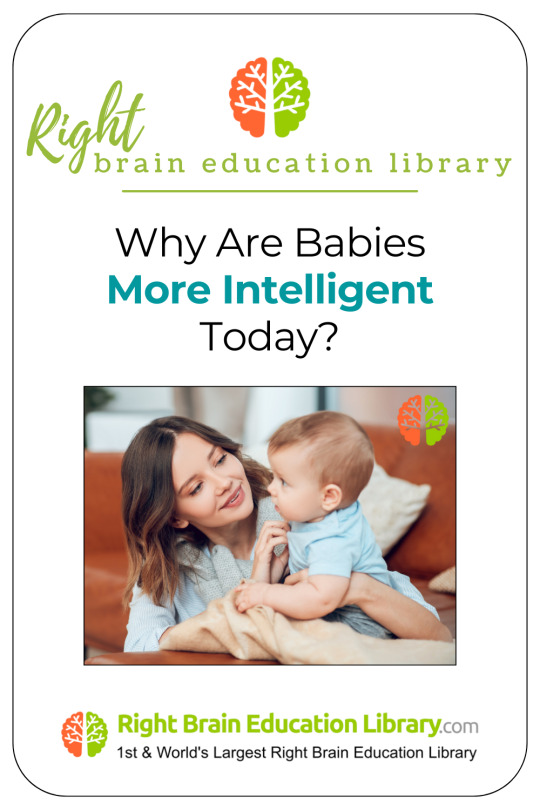
❤️ Babies and toddlers are more intelligent today.
Why?
Because modern parents understand the importance of early education and know how to nurture their child positively, which contributes to their intelligence.
Here are what makes a baby more intelligent...
❤️Positive Parenting
Modern parents use positive communication to nurture their child's development. By embracing a "yes you can" attitude, they instill confidence and self-belief.
Positive language fosters emotional well-being and cognitive growth, helping children build resilience and a positive self-image.
This approach strengthens the parent-child bond and equips children to face challenges with optimism.
❤️Positive Environment
Parents can create a nurturing educational environment despite external limitations. Bright, positive colors in a child's room can promote a conducive learning atmosphere.
A positive environment stimulates cognitive growth and emotional well-being, laying a strong foundation for future development.
❤️Super Brain Food
Parents today recognize the importance of good nutrition for brain development.
The first (1, 2, 3) three years are crucial, with the brain reaching 80% of adult size by age 3. Modern babies learn quickly, making historical data on earlier generations less accurate.
❤️Innovative Early Education Method
Parents now prefer scientific early education methods over traditional ones. New approaches combine the best practices to make learning faster, easier, and more enjoyable.
These methods prioritize scientific rigor and improve traditional education techniques.
❤️Why are babies more intelligent today?
Positive parenting, a nurturing environment, optimal nutrition, and innovative education methods contribute to faster learning and increased intelligence in babies today.
💎Discover the Right Brain Education Method of learning for baby and toddler intelligence.
#earlylearning#earlylearning101#rightbraineducationlibrary#rightbraineducation#rightbraintraining#babylearning#toddlerlearning#toddlerlearningactivities#shichida#hegurumethod#shichidamethod#glenndoman#glenndomanmethod#Edited · 55 m
0 notes
Text
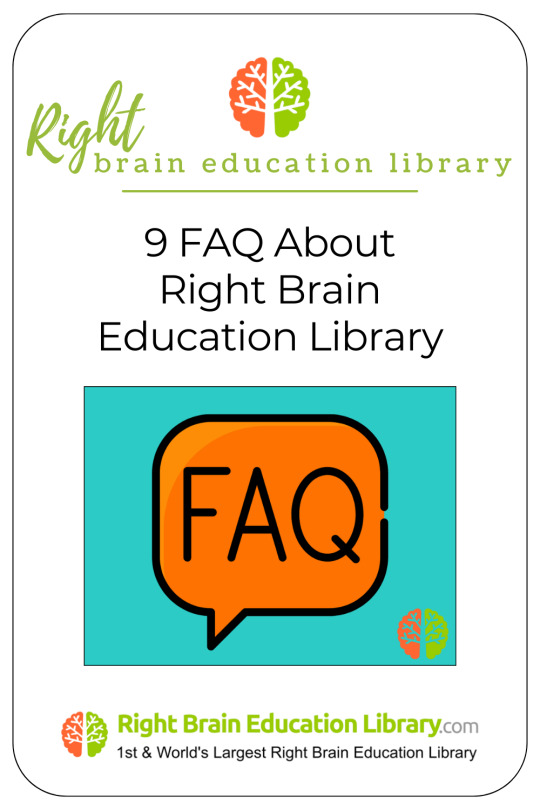
💎Flashcard program for babies and toddlers (6 months old to 7 years old)...
❤️ 1. What is Right Brain Education Library?
The Right Brain Education Library is the world's largest early learning library for children aged newborn to 6, featuring flashcards and memory activities based on the Right Brain Education Method.
❤️ 2. Why Right Brain Education Library?
It provides materials based on proven methods from Shichida, Heguru, and Glenn Doman, with over 19 years of experience in developing early learning resources.
❤️ 3. Why use the library if my child is in a program?
The library complements enrichment programs by offering additional materials for practice, enhancing your child's learning experience.
❤️ 4. Can I use the library without attending a right brain school?
While the library is beneficial on its own, attending classes like Shichida and Heguru is recommended for social skills and classroom preparation.
❤️ 5. How to integrate lessons with the library?
The library includes a "Home Practice Guide" with charts and lesson plans to blend with Shichida, Heguru, and Glenn Doman teachings, plus a "Click & Play" flashcard program for easy daily lessons.
❤️ 6. Can I DIY/Homeschool my child?
Yes, with the library's resources and support, you can effectively homeschool your child.
❤️ 7. How do library flashcards compare to others?
The library offers the largest and most diverse collection, featuring realistic images and Montessori fonts.
❤️ 8. The Right Brain Education Library is an "Active Learning Program".
The program emphasizes active learning, providing access to thousands of flashcards and puzzles, along with a "Home Practice Guide" for parents.
❤️ 9. If I still have questions?
Contact [email protected]
Subscribe to our newsletter and download the "Right Brain Education Manual" for more information at
👉www.RightBrainEducationLibrary.Com
#rightbraineducation#rightbraineducationlibrary#rightbraintraining#shichida#heguru#shichidamethod#hegurumethod#glenndoman#glenndomanmethod#babyflashcards#montessori#montessoriathome#montessoriactivity#toddlerflashcards#flashcardsfortoddlers
0 notes
Text
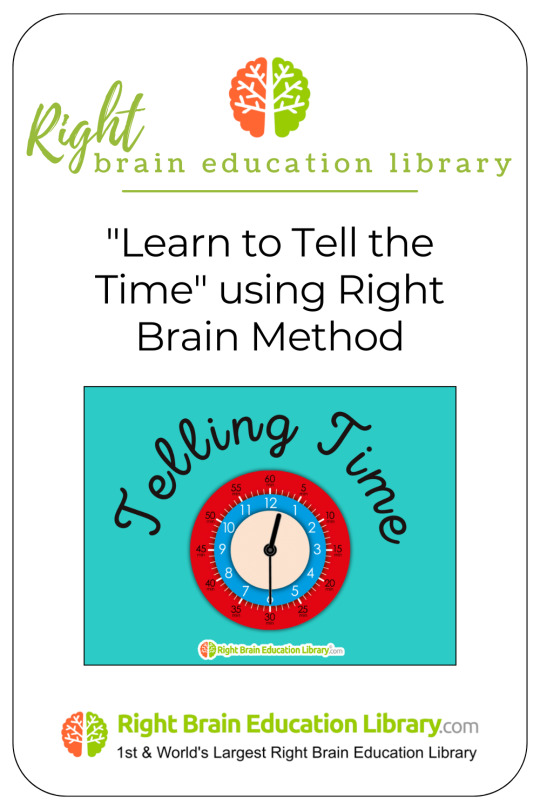
Do you know that teaching your baby or toddler to tell the time is not just a practical life skill but also an integral part of learning foundational math concepts?
⏰Understanding how to read a clock can significantly enhance your child's cognitive development and mathematical abilities. The process of learning to tell time involves recognizing numbers, understanding sequences, and grasping the concept of intervals, all of which are essential components of early math education.
👉Especially for children aged 6 months to 3 years old, introducing the concept of time can be both fun and educational.
👉One of the most effective methods for teaching your child to tell the time is through the use of flashcards. Flashcards engage young minds visually and can make learning more interactive and enjoyable.
👉By using colorful and appealing images, children can better associate the numbers on a clock with the corresponding times, making it easier for them to grasp these concepts. This method not only aids in recognition but also helps reinforce memory through repetition and visual stimulation.
❤️At RightBrainEducationLibrary.Com, we are dedicated to providing innovative resources for parents who want to teach their children how to tell time using the Right Brain Education Method.
💡This approach incorporates techniques from renowned educational philosophies such as the Glenn Doman, Shichida Method, and Heguru Method.
💡These methods emphasize the importance of early learning and utilize various sensory experiences to enhance cognitive development.
👉We invite you to explore our extensive flashcard program.
👉With 44,720 flashcards and hundreds of Right Brain Memory exercises designed to enhance your child's learning experience.
👉These exercises include Photographic Memory, Speed Reading, Mandala Memory Puzzles, Linking Memory, and many more.
👉Each of these activities is crafted to stimulate your child's brain, and promote memory retention.
❤️Visit www.RightBrainEducationLibrary.Com
#rightbraineducation#shichida#heguru#glenndoman#rightbraineducationlibrary#shichidamethod#hegurumethod#montessoriathome#earlylearning#babyflashcards
0 notes
Text
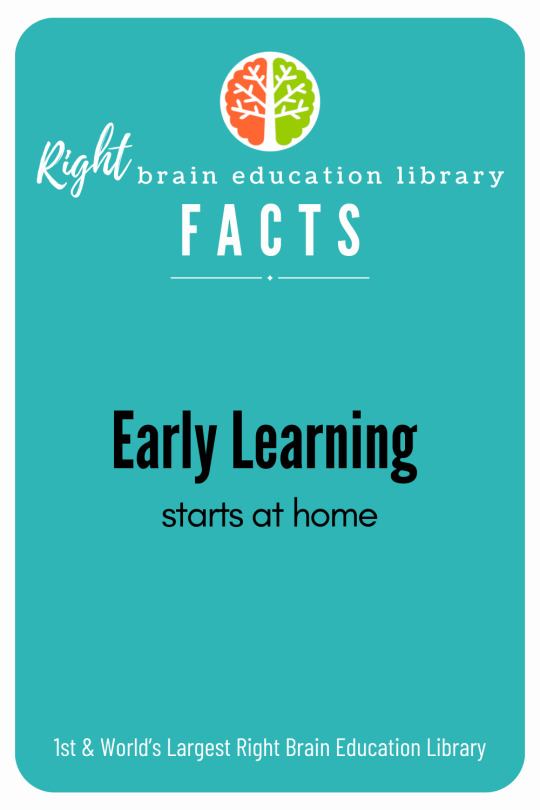
❤️Early Learning Begins at Home...
💎Early learning methods like Right Brain Education, which include the Shichida Method, Heguru Method, and Glenn Doman Method, truly start at home.
👉In this familiar setting, you can cultivate a nurturing environment that stimulates curiosity and exploration, forming the basis for your child's future educational experiences.
👉Engaging with your baby or toddler at home prepares them for the structured environments of kindergarten or preschool, where foundational skills will be further developed and refined. To begin this enriching educational journey, consider integrating flashcards into your daily routine.
👉These flashcards can cover a wide range of subjects, focusing on key areas such as math, vocabulary, and reading.
👉Introducing these concepts early enhances your child's cognitive abilities and language skills in a fun and interactive manner.
👉Flashcards can be made engaging with colorful images and playful themes that capture your child's attention, turning learning into an enjoyable experience rather than a task.
💎Your child's foundational development is crucial, especially between the ages of 4 months and 3 years. This is a vital period for acquiring knowledge, as their brains are developing rapidly.
💎During formative years, neural pathways for future learning are established. Activities that stimulate senses, encourage problem-solving, and foster creativity are crucial. Simple games, reading, and imaginative play aid development significantly.
💎A balanced approach that includes intellectual and emotional growth sets the stage for a well-rounded education, benefiting your child throughout life.
💎Parents play an invaluable role in early learning. By engaging in your child's education early, you facilitate academic readiness and nurture a lifelong love of learning.
💎Embrace early education at home and watch your child thrive, equipped with essential skills for their educational journey.
#rightbraineducation#rightbraineducationlibrary#rightbraintraining#shichidamethod#hegurumethod#glenndoman#glenndomanmethod#earlylearning#babyflashcards
0 notes
Text

Do you know what is common for all the successful tech billionaires, sports legends, to great musicians?
All of them start learning or training early. If you look at Rafael Nadal's age of 3 years old, Novak Djokovic's age of 4 years old. They were both trained by professional tennis coaches.
Tiger Woods, the legendary golfer, started learning golf at the age of 18 months old.
Bill Gates and Steve Jobs learned programming at the age of 13 years old (50 years ago).
Lang Lang, the modern legendary pianist, started learning the piano at the age of 3 years old and did his public recital at the age of 5 years old.
Their success comes from starting early. Not luck.
How did these athletes, musicians, and billionaires become masters in their field?
They all started their training early.
The key to unlocking a child's potential lies in starting their educational journey as early as possible.
Research has shown that the formative years of a child's life are crucial for cognitive development, making early learning not just beneficial but essential. By introducing educational concepts during infancy, parents and educators can significantly enhance a child's ability to absorb information and develop critical thinking skills.
The key is to start your baby or toddler's early learning early.
To build a solid foundation, parents are encouraged to engage their babies or toddlers in Right Brain Education training, particularly during the critical developmental window from 6 months to 3 years old.
Discover more: www.RightBrainEducationLibrary.Com
#rightbraineducation#earlylearning#rightbraineducationlibrary#rightbraineducationathome#rightbraineducationindia#shichidamethod#shichidaaustralia#heguruaustralia#heguru#glenndoman#earlyeducation
0 notes
Text

Right Brain Education for babies and toddlers extends beyond reading, math, and encyclopedic knowledge.
Just like physical exercise strengthens muscles, brain exercises enhance intelligence.
❤️Engaging in brain exercises stimulates cognitive development, crucial for future learning and growth.
Brain training helps babies and toddlers: 1. Think independently 2. Think creatively 3. Concentrate and focus 4. Develop long-term memory
❤️ By age 5, a child's brain develops approximately 90% of its capacity, marking a critical period for cognitive growth.
❤️The first 5 years are crucial for building brain muscle with Right Brain Education, yet many parents overlook this.
💎 The Right Brain Education Method emphasizes not only math, reading, and vocabulary but also photographic memory and speed learning.
❤️How Do You Build Your Baby's Brain Muscle with Right Brain Education?
❤️Flashcards and memory exercises are essential. They help children learn math, vocabulary, and encyclopedic knowledge while enhancing memory.
💎 Flashcards are a proven tool for learning and memorizing.
❤️ Memory exercises like the Mandala memory program, photographic puzzles, and Tangram train the brain's memory muscle.
❤️Where To Start Your Baby Or Toddler's Brain Training?
Explore the Right Brain Education Library, the largest collection of flashcards and memory exercises for children (ages 0 to 7 years).
This library aids in teaching math, reading, vocabulary, and enhancing cognitive abilities.
Start introducing your baby or toddler to Right Brain Education at home today!
www.RightBrainEducationLibrary.Com
#rightbraineducation#rightbraineducationlibrary#rightbraintraining#shichidamethod#hegurumethod#glenndomanmethod#earlylearning#babyflashcards#toddlerflashcards#montessoriathome
0 notes
Text
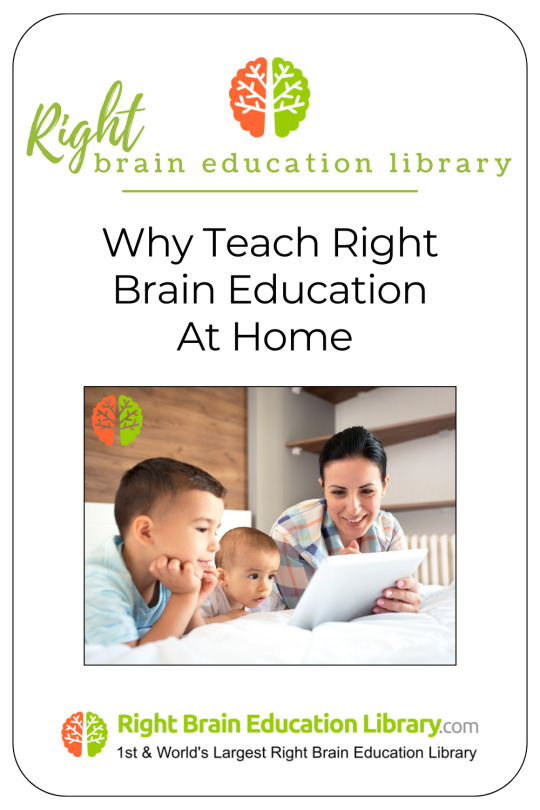
👉 Right Brain Education is an early learning method for 6 months old, 1, 2, 3 to 5 years old. It focuses on the child's brain development training.
When teaching right brain education at home with your baby or toddler, you need flashcards and right brain education memory exercises. This article will touch on the importance of flashcards in teaching your child at home.
❤️Why Teach Your Baby Or Toddler Right Brain Education Flashcards at Home?
Implementing right brain education flashcards at home offers numerous benefits for your child's development. Here are key reasons to consider:
💎Learn New Vocabulary. Flashcards with vibrant images and words help children expand their vocabulary interactively, enhancing retention and understanding.
💎Learn Math. Flashcards introduce basic math concepts, building a strong foundation for future learning.
💎Develop Encyclopedic Knowledge. Flashcards covering various topics encourage curiosity and a love for learning through engaging visuals and facts.
💎Stimulate Right Brain Development. Flashcards enhance creativity, emotional intelligence, and problem-solving skills, crucial for holistic brain development.
💎Learn Multiple Languages. Flashcards introduce new languages by associating words with images, fostering bilingual or multilingual abilities.
💎Develop a Better Memory. The repetitive use of flashcards improves memory retention, benefiting children's educational journey.
💎Training for Speed Reading. Flashcards promote speed reading skills, enhancing reading fluency and comprehension.
💎Develop Photographic Memory. Visually stimulating flashcards aid in developing a photographic memory, advantageous in academic pursuits.
Discover more,
www.RightBrainEducationLibrary.Com
#earlylearning#rightbraineducation#rightbraineducationlibrary#glenndomanmethod#glenndomanflashcards#babyflashcards#toddlerflashcards#shichidamethod#heguru#shichida#hegurumethod
0 notes
Text

❤️Do you teach your baby or toddler based on their age or competency?
This question is crucial for parents and educators alike as they navigate the early stages of childhood learning.
💡Let's look at the Right Brain Education (Shichida Method, Heguru Method, and Glenn Doman Method).
👉Here are our observations regarding early childhood education...
🌏Our research indicates that those babies or toddlers who began their flash card lessons at an early age tend to progress at a much faster rate compared to their peers who started these educational activities later in life.
This is not merely a coincidence; it reflects the significant impact that early exposure to structured learning can have on a child's cognitive development.
💎For instance, it is quite remarkable to observe that some children as young as 2 years old are able to grasp concepts and knowledge that typically align with what a 4-year-old would learn.
This isn't about putting any kind of pressure on the kid to hit these milestones; it's more about the benefits they get from starting educational activities early.
Such early engagement allows the child to build a strong foundation that supports their ongoing learning journey.
So, here's the big question: should we teach kids based on their age or what they're actually good at?
When it comes to Right Brain Education—which includes the Shichida Method, Heguru Method, and Glenn Doman Method—we're all about a personalized approach. We think teaching should focus on...
💡The child's unique interests and natural talents, not just their age.
and
💡Making flashcard lessons not only educational but also fun and engaging.
The Right Brain Education Library has been a vital resource for parents seeking to teach their babies or toddlers effectively for the past 19 years.
We have extensive resources and programs to help parents with their teaching journey, giving them the tools to support their child's growth.
❤️www.RightBrainEducationLibrary.Com❤️
#rightbraineducationlibrary#rightbraineducation#shichidamethod#hegurumethod#earlylearning#glenndoman#glenndomanmethod#shichida
0 notes
Text
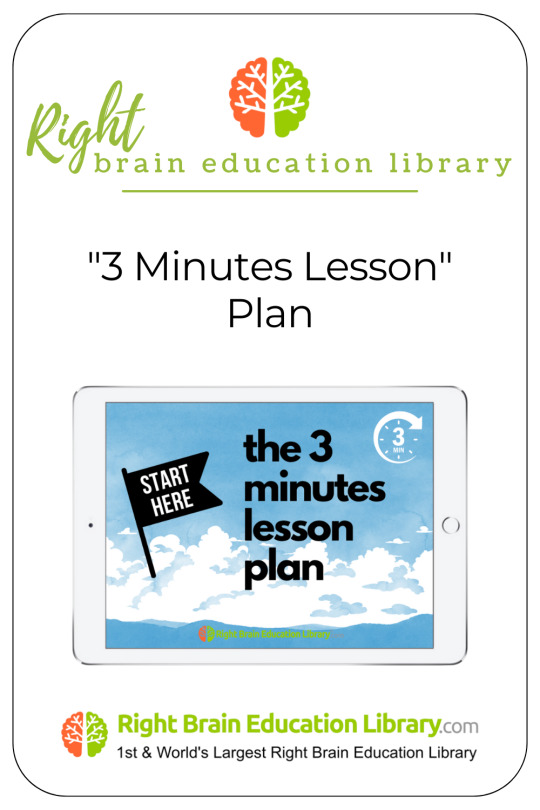
❤️👉Teaching your baby or toddler Right Brain Education is easy when you follow our "3 Minute Lesson Plan".
💡This is a weekly lesson plan where all the flashcards and right brain exercises are prepared for you to teach your baby or toddler at home or anywhere you may be.
❤️You do not need any experience. Just select the lesson and teach. All prepared for you.
💡You can also add on more flash cards for your child to learn from the Right Brain Education Library's 44,720 flash cards.
❤️The "3 Minute Lesson Plan" is designed for kids who are currently going to Shichida, Heguru, or Right Brain Education classes.
💡However, IF YOU DO NOT HAVE any "right-brain" schools near your place and want to teach your child at home, the "3 Minute Lesson Plan" is suitable.
🌈Discover how you can teach your baby or toddler at home.
👉www.RightBrainEducationLibrary.Com
#rightbraineducationlibrary#rightbraineducation#rightbraineducationathome#shichida#shichidaflashcards#shichidamethod#heguru#hegurumethod#earlylearning#montessori#montessoriathome#montessoriactivity#montessoriflashcards#glenndoman#glenndomanmethod#babyflashcards#toddlerflashcards
0 notes
Text

🌟AI Learning is now a core subject for 6-year-olds in China's national schools.
As parents, we should always prepare our baby or toddler for their future.
💡China is incorporating AI education into the curriculum for first graders as a strategic initiative. By age 11, students learn AI and robotics integration.
This is a decisive move.
China is investing in a future led by AI-savvy children.
🤷♂️Meanwhile, most countries? - They are still discussing the appropriateness of smartphones and screen time in classrooms. - In China, AI has become a mandatory subject in schools. - Beginning in September 2025, AI will be a core subject. - Students will approach it with the same importance as math or reading.
❤️China isn't isolated—it's leading the way. - Italy and California are exploring similar paths - Some schools are piloting AI lessons - Many remain in the "What if" phase - China has advanced to "What next"
👉What about your role as a parent? - Are we equipping our children for the future? - Or are we hoping technology will pass them by? - Will your children be AI creators or AI subjects? - Age 6 is now the starting line.
👉If AI is the new literacy, then digital illiteracy equates to new poverty. - What happens when AI becomes a native language? - What are children innovating while we deliberate?
❤️If your child is from 0 to 5 years old. - Are we educating our children with devices? - Are we preparing our child for their new world? - Digital devices are integral to your child's life. Embrace the future by leading, guiding, educating, and participating in their early learning.
🌏A baby or toddler's educational foundation begins at home. Prepare your child's future starting at home.
Discover more... www.RightBrainEducationLibrary.Com
1st & World's Largest Right Brain Education Library for babies and toddlers.
#rightbraineducationlibrary#rightbraineducation#babyflashcards#toddlerflashcards#earlylearning#montessoriathome#montessori#shichida#shichidamethod#hegurumethod#glenndoman
0 notes
Text
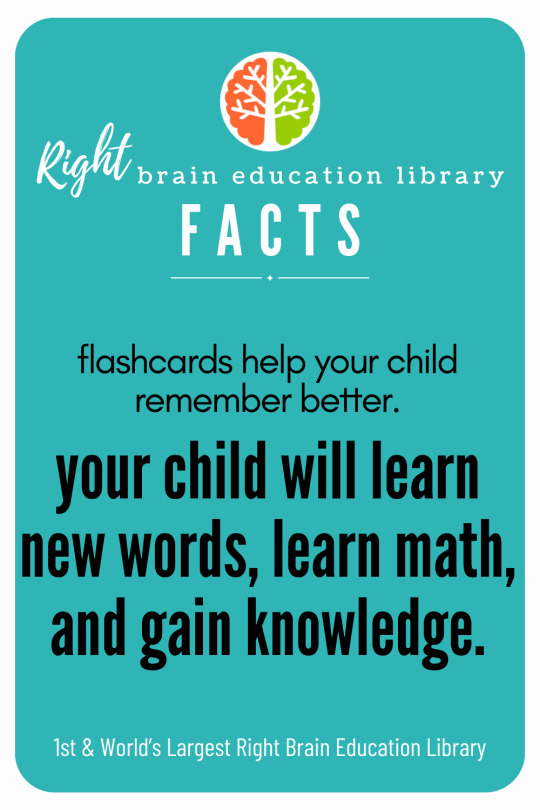
Flash cards are used to teach babies or toddlers, vocabulary, math, and encyclopedic knowledge.
Flash cards are sometimes called memory cards.,because it is an effective tool to teach your child new words and memorize.
As Glenn Doman said,
"With knowledge comes intelligence"
Only though knowledge you can gain intelligence.
Our Right Brain Education program comes with 44,720 flashcards and lots of right brain memory exercises like
Mandala Memory Linking Memory Tangram Puzzles Photographic Memory puzzles Peg Memory Speed Reading and Many more
🌎Visit our site now at,
❤️www.RightBrainEducationLibrary.Com
#rightbraineducation#rightbraintraining#rightbraineducationlibrary#rightbraineducationathome#rightbraineducationactivities#shichida#shichidamethod#heguru#hegurumethod#glenndoman#glenndomanmethod#glenndomanflashcards
0 notes
Text
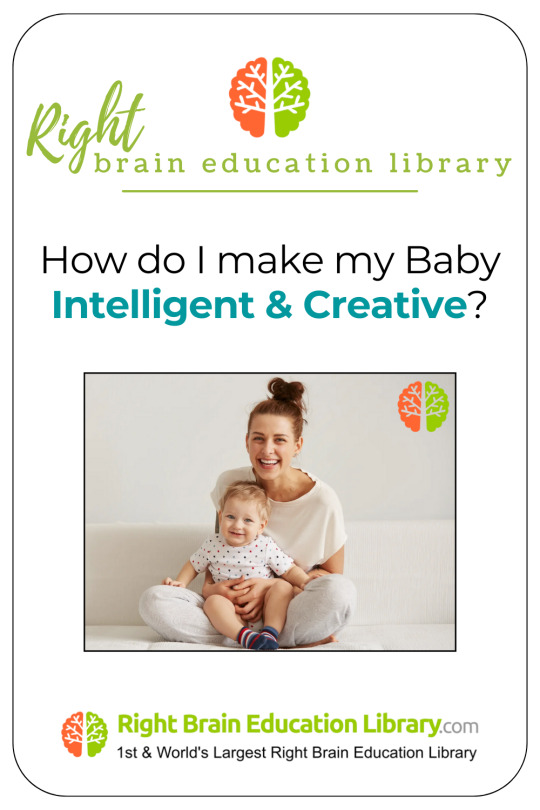
Your baby or toddler's intelligence depends on what you expose your child to. Here are some tips on how to make your baby intelligent.
1. Environment: Make sure you provide a space for the baby to learn. For example, it could be a corner where you can surround your baby with books and educational toys. Make sure these toys are suitable . At the same time parents must be physically there to spend time bonding and teaching.
2. Make sure you have lots of flash cards to expose your child with new words, pictures and sounds for your child to learn. Flash cards are great way to expose new information for your baby to learn.
During the first three years of a child, they absorb and learn like a sponge. What they see and hear they will learn.
Take advantage to teach your child and nurture them in a positive environment at this young age and they will have a very strong foundation in their future education.
The more the baby learn, the more knowledge they have. Knowledge is a key step towards developing intelligence.
Visit www.RightBrainEducationLibrary.Com.
We have 44,720 flash cards and right beain memory exercises.
#rightbraineducation#rightbraineducationathome#rightbraineducationlibrary#shichida#shichidamethod#shichidamaterials#heguru#hegurueducation#glenndoman#glenndomanmethod#glenndomanindonesia#rightbraineducationindia
0 notes
Text

In Shichida Method, Heguru Method and Glenn Doman Method, flashcards are used to teach babies and toddlers new vocabulary, math and general knowledge.
It all started through the discovery of a Tachistoscope.
Tachistoscope is memory machine used during World War 2 by the military to teach their soldiers to remember the enemy's vehicles.
This memory machine flashes images on a screen at a fast speed.
Based on research, by showing the flash cards fast, soldiers were able to remember and identify the enemy's vehicles presented to them.
Flash cards are used by Shichida Method, Heguru Method and Glenn Doman Method to teach babies and toddler
Today many parents are using flashcards to teach their baby or toddler at home.
You too can teach your baby or toddler at home. Discover more by visiting,
www.RightBrainEducationLibrary.Com
#rightbraineducation#rightbraintraining#rightbraineducationathome#shichida#shichidamethod#shichidaflashcards#glenndomanmethod#glenndoman#glenndomanflashcards#heguru#hegurueducation#hegurumethod#rightbraineducationlibrary#babyflashcards#rightbraindevelopment#rightbraineducationsingapore#flashcardsforbabies#flashcardsfortoddlers#shichidaaustralia#shichida method#shichidathailand
0 notes